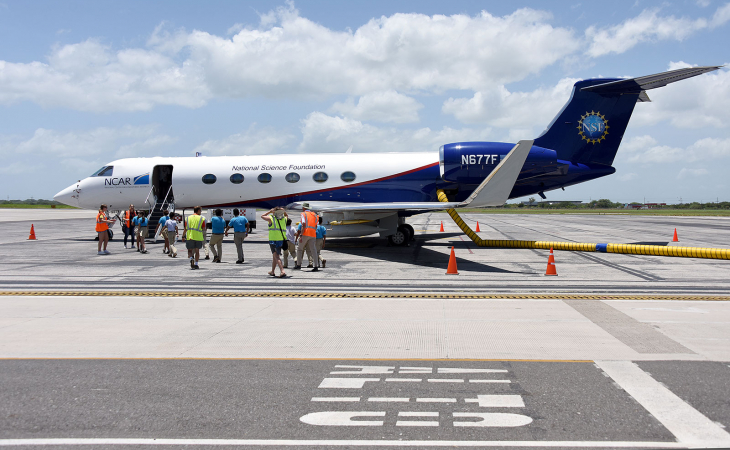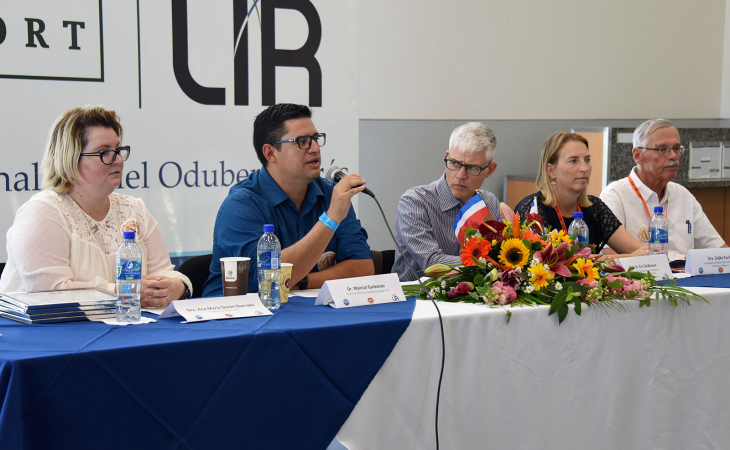With the aid of an airplane equipped with state of the art technology that allows taking measurements from the air, researchers from different countries collaborate in an effort to better understand the physical processes related to the origin of tropical storms and hurricanes.

The Gulfstream-V aircraft, used for research by the National Science Foundation and the National Center for Atmospheric Research in the United States, is in Costa Rica conducting a study on the formation of the clouds that produce intense storms and the genesis of the hurricanes. (Photo: IDI / Laura Rodríguez-Rodríguez)
From August 5 to September 30, the Gulfstream-V aircraft overflies the national airspace to collect data used for research by the NSF and the United States National Center for Atmospheric Research (NCAR).
Costa Rica was chosen in this study due to its geographical location between the Pacific Ocean and the Caribbean Sea. Sea surface temperatures vary between the two oceans, which has not been fully investigated and a better understanding of the effects of convection is needed.
Convection occurs when air rises or falls due to temperature differences. This constitutes one of the forces linked to the formation of tropical cyclones of great intensity.
Dave Raymond, a researcher from New Mexico Tech and one of the fieldwork leaders, thanked the contributions of his colleagues from the University of Costa Rica (UCR), Ana María Durán-Quesada and Marcial Garbanzo- Salas, from the School of Physics and of the Center for Geophysical Research (CIGEFI). They coordinate the project for UCR.
Raymond explained the social importance of this research: “Time is a global machine with many parts and each one is very important. We do not understand the part of Central America and the oceans very well, the distribution of sea temperature here is very different from other parts of the world. These studies will help to improve our understanding of the weather and of all the factors related to weather forecasting.”
And according to specialists, knowing how intense storms form contributes to planning and risk management in the event of meteorological phenomena.
The OTREC project also makes observations from terrestrial platforms located in different locations in the country, with instruments of various types, including radiosondes, weather stations, a global positioning system, and precipitation water collectors.
There are instruments connected in 13 places, from residential houses to companies and hotels, from where how atmospheric systems move over the country is monitored, Ana María Durán stated.
Equipment has been installed at sites such as Limón Airport, at the UCR Atlantic and Guanacaste campuses, in Potrero Cerrado, Cartago, at the Orígenes de Jacó Hotel, in Hacienda Barú near Playa Dominical, at the Papagayo Marina in Guanacaste, in Bijagual, Turrubares, in Santa María de Dota and in Guayabo de Mora, among other places.
“Locals watch over the equipment to prevent vandalism. They let us know if the equipment is not working well. Every two weeks we visit the places to collect the samples and to review and download the data, which are also obtained online,” said the UCR researcher.
As part of its educational mission, the OTREC project created an open door space on August 28 at the Daniel Oduber Quirós International Airport, in Liberia, Guanacaste, with the goal of sharing the experience of doing science with local students.
Primary and secondary school children and students from the Physics and Meteorology majors from UCR had the opportunity to talk with part of the scientific team of the project, board the Gulfstream-V aircraft and learn the details of the instruments used in the scientific campaign.
“These opportunities are unique because students can know firsthand the objectives of OTREC and the scientific questions that are waiting to be answered with the help of the set of data collected during the campaign. In addition, students learn about different types of measuring instruments and observation methods,” said Erick Rivera-Fernández, a professor at the School of Physics.
“The idea is that based on the information generated, there will be a better understanding of the processes that form convective systems in the southwest Caribbean and the eastern tropical Pacific, as well as some characteristics of the low-level jet stream of the Caribbean,” he added.
For his part, Eric DeWeaver, program manager for OTREC at the NSF, stressed that the National Science Foundation supports research in the area of basic sciences, in this case on the formation of rain, the behavior of clouds in the tropics, and how these clouds form hurricanes.
"We do not have the task of making a weather forecast, but rather we focus on developing the fundamental science necessary to create the technology with which the weather is forecast," he said.
Zeljka Fuchs Stone, a researcher from New Mexico Tech, is a scientist of Croatian origin responsible for organizing all the logistics related to the Gulfstream-V plane flights and making sure that work from the air is carried out to perfection.
20 flights are scheduled with the research ship that crosses the Costa Rican skies during two months of fieldwork in Costa Rica. “We will fly in stormy and calm weather. We want to take measurements when the storm develops, but also just before and shortly after,” said Fuchs.
Each flight lasts six hours. In the air, they face some risks, such as the effects of lightning. "We try to fly above lightning bolts, because they can be dangerous when we fly through the clouds," she said.
Much of the technology used on the plane has been adapted by scientists and engineers according to the needs of the project. For example, there are probes that fall from the plane to the ocean and measure variables such as temperature, humidity, pressure, and wind. Each probe has a cost of $1000 and on each flight, they launch 32.
In addition, under the wings of the plane, there is a very sophisticated equipment, a cloud radar with which the plane enters the different types of clouds, among them cumulus (the cotton-like ones) that produce very intense rains. They also have other devices placed outside the ship used to measure the size, speed, and distribution of the cloud drops. All this information is captured through a computerized monitoring and control system located within the Gulfstream-V aircraft.

Marcial Garbanzo and Ana María Durán (to the left) are the coordinators of the Otrec project on behalf of UCR. Eric DeWeaver Otrec NSF program manager, Zeljka Fuchs Stone and Dave Raymond, researchers from New Mexico Tech, also participated during the presentation to students. (Photo: ODI / Laura Rodríguez-Rodríguez)